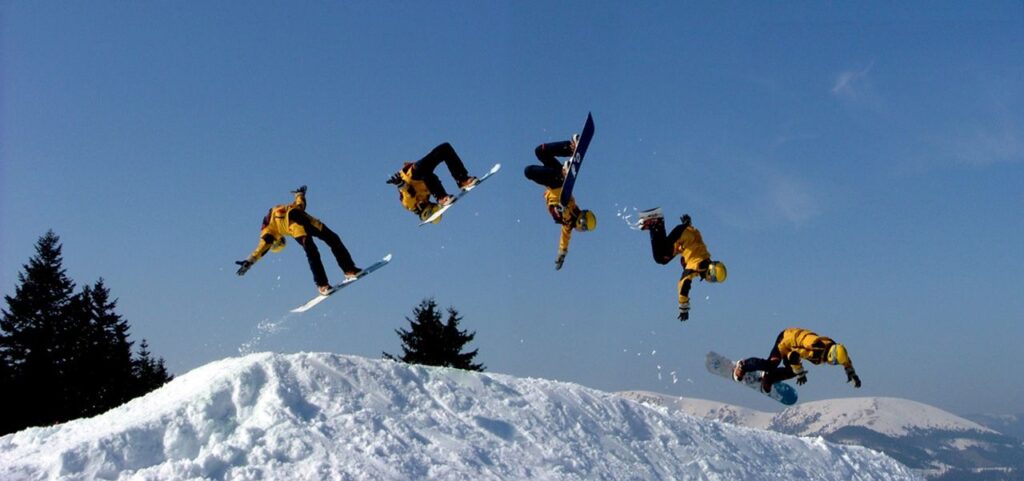
What is energy?
Energy is difficult to define. Broadly speaking, it is a quantity associated with a system of objects that is always conserved. When a quantity is conserved, it means that it never increases or decreases. It can’t be created or destroyed.
Energy comes in a variety of forms. Energy can be transformed from one form to another (e.g from gravitational potential energy to kinetic energy), and our ways of calculating energy allow us to accurately account for energy when it is transformed.
Energy isn’t a fundamental quantity (like time or distance), but the relationship between other quantities like mass and velocity (kinetic energy). E.g. kinetic energy is the energy of movement and can be calculated using EK = ½mv2.
Energy is a scalar quantity and can never be negative.
Why is energy such a useful quantity?
After countless experiments, scientists realised that energy quantities can be used to predict the outcomes of experiments and to build machines, such as flying machines.
This success is based on a wonderful property of our universe:
Energy can be transformed from one type to another and transferred from one object to another, but the total amount is always the same (energy is conserved).
We say that the total energy of an isolated system is conserved.
(An isolated system is one that is separated from in its surroundings in such a way that no energy is transferred into or out of the system.)
What are the different types of energy?
Energy can be classified into two main types:
- Mechanical energy is the energy that is possessed by an object due to its motion or due to its position.
Mechanical energy can be either kinetic energy (energy of motion) or potential energy (stored energy because of an object’s shape or position in a field) e.g. Gravitational Potential Energy, elastic potential energy.
The focus of this topic is mechanical energy. - Non-mechanical energy (that’s everything else e.g. chemical potential energy, nuclear energy, thermal energy. Our syllabus also lists light, electromagnetic radiation, sound and heat.)
What are energy transformations?
We describe energy transformations concisely using an arrow (like in a chemical reaction).
Energy transformations are a process. It is better to describe when they are happening instead of where they are happening.
The barbell has much more gravitational potential energy when high above the weight lifter’s head than when on the floor. To lift the barbell, she transforms chemical energy in her body into gravitational potential energy of the barbell. We can simply write:
While the weightlifter lifts: Echemical potential → EP
The wood contains considerable chemical energy. When the carbon in the wood combines chemically with oxygen in the air, this chemical energy is transformed largely into thermal energy of the hot gases and embers.
Echemical potential → Ethermal

At the instant shown, the board is flexed to its maximum extent, so that elastic potential energy is stored in the board. Soon this energy will begin to be transformed into kinetic energy; then, as the diver rises into the air and slows, this kinetic energy will be transformed into gravitational potential energy.
While the board straightens, lifting the diver: EP → EK
After the diver has left the board and is moving upwards: EK → EP
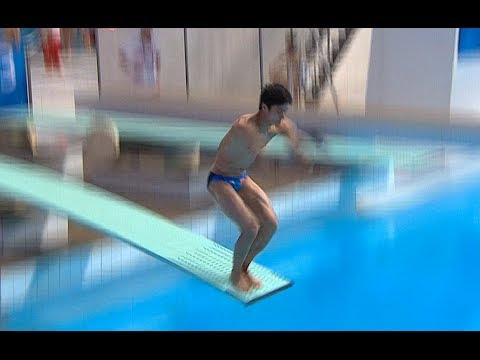
Kinetic Energy
What is kinetic energy?
Kinetic energy is the energy associated with the movement of an object.
Work and energy
What is a system?
In physics, a system is simply a portion of the physical universe chosen for analysis. Everything outside the system is known as the environment. The environment is ignored except for its effects on the system.
A system can consist of one or more objects. It can be as simple as a falling gumnut or as complex as a city. The split between system and environment is the analyst’s choice, generally made to simplify the analysis. For example, the water in a lake, the water in half of a lake, or an individual molecule of water in the lake can each be conside
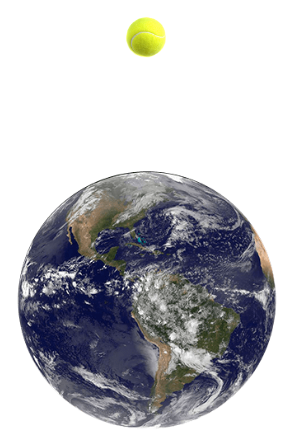
How does energy change in an isolated system?
An isolated system is one that is separated from in its environment in such a way that no energy is transferred into or out of the system. This means that no work is done on the system. Energy within the system can be transformed but the total energy of the system remains constant. We say that the total energy of an isolated system is conserved. There is no change in the total energy of the system.
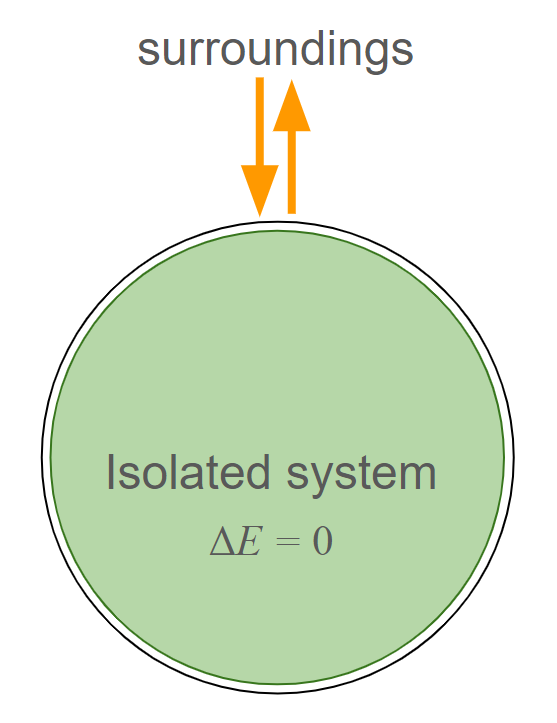
For an isolated system:
We can use the law of conservation of energy to solve many problems in physics.
Is mechanical energy really conserved?
In the absence of friction and other resistive forces, such as air resistance, mechanical energy is conserved. Sometimes potential energy stored in springs is also considered a form of mechanical energy.
Often we make the approximation that mechanical energy is conserved in the real world. This makes calculations simpler. When objects are moving slowly so air resistance is small, and there are no solid surfaces sliding against each other, this is a reasonable approximation.
In reality, mechanical energy is almost never conserved. Real systems usually have friction acting. When the kinetic friction force acts to slow down an object, the kinetic energy lost by the object is converted into the random kinetic energy of the atoms on the surfaces – the surfaces get warmer. This random kinetic energy of microscopic particles is not considered a form of mechanical energy.
How can energy be transferred to a system?
The energy of the system may change as a result of interactions with its surroundings.
An exchange of energy between the system and its environment is called an energy transfer.
There are two main energy transfer processes:
- Work is the transfer of energy to or from a system by pushing or pulling on it. We use the symbol, W, for work.
- Heat is the non-mechanical transfer of energy because of temperature differences. We use the symbol, Q, for heat. (Not in the Physical sciences course).
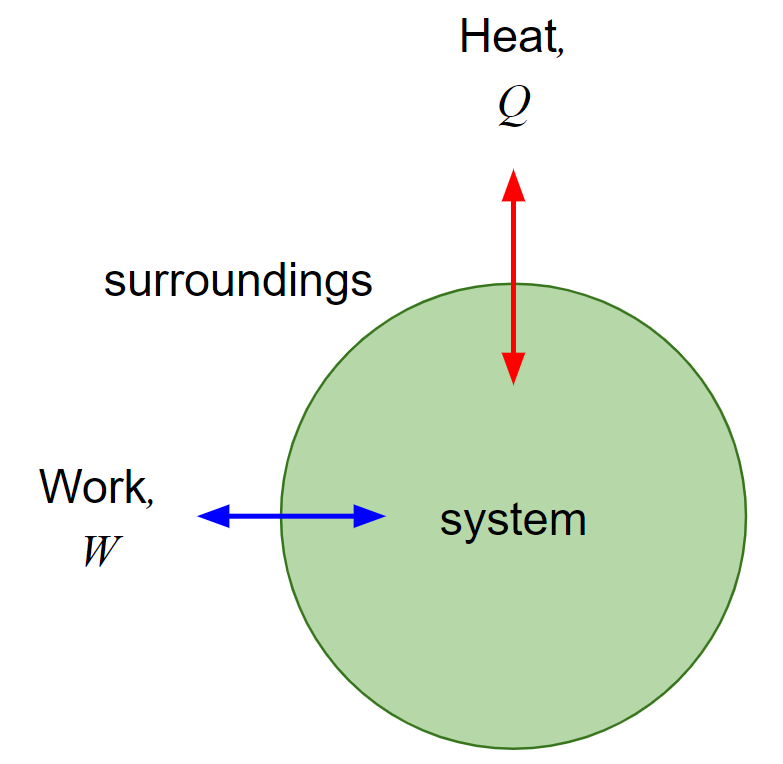
How can work transfer energy to a system?
Work is the transfer of energy to a system by pushing or pulling on it.
Specifically, work is energy transferred from the environment to a system, or from a system to the environment, by the application of mechanical forces (pushes or pulls) to the system. Once the energy has been transferred to the system, it can take many forms.
We also refer to the process of transferring energy as “doing work” on the system, or the system “doing work” on its surroundings.
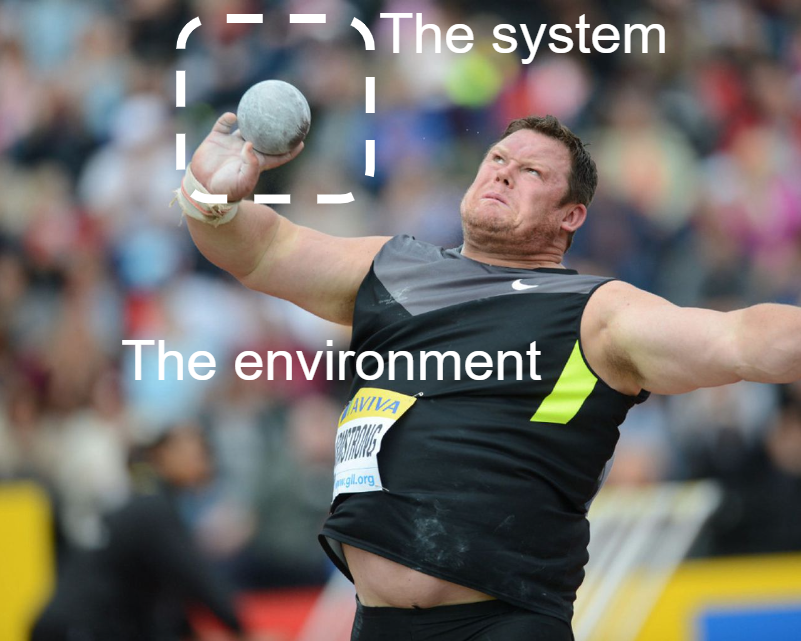
The system: the shot
The environment: the athlete.
As the athlete pushes on the shot to move it, he is doing work on the system. That is, he is transferring energy from himself to the shot. The energy transferred to the system appears as kinetic energy.
Can work be negative?
Energy transferred to the system is positive work, and from the system, negative work.
If you accelerate an object to a greater speed by applying a force to the object, you increase the kinetic energy of the object.
Similarly, if you decelerate the object to a lesser speed by applying a force, you decrease the kinetic energy of the object.
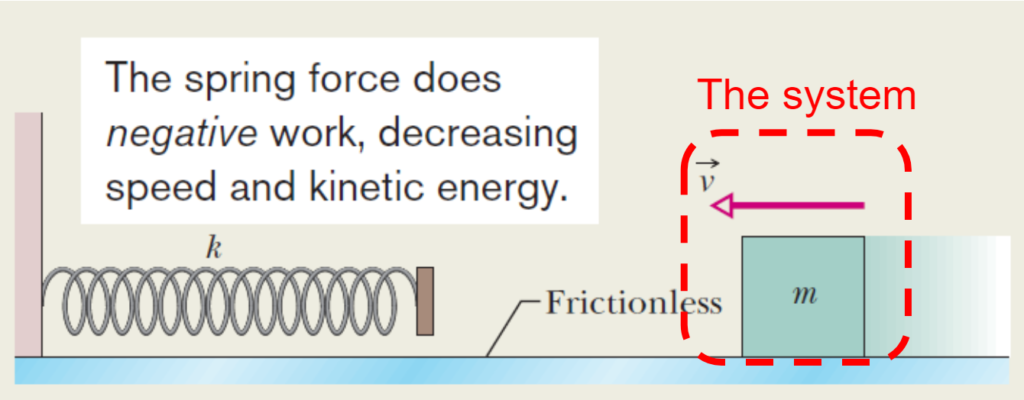
In this example, the spring applies a force to the box, which transfers energy from the box, decreasing its kinetic energy. The spring does negative work on the box.
The energy of the box is transformed into elastic potential energy in the spring.
If work is negative, where does the energy go?
If we consider the box-spring system, the force of the box on the spring is internal, the total energy of the system remains constant, and there is a transformation of kinetic energy into potential energy.
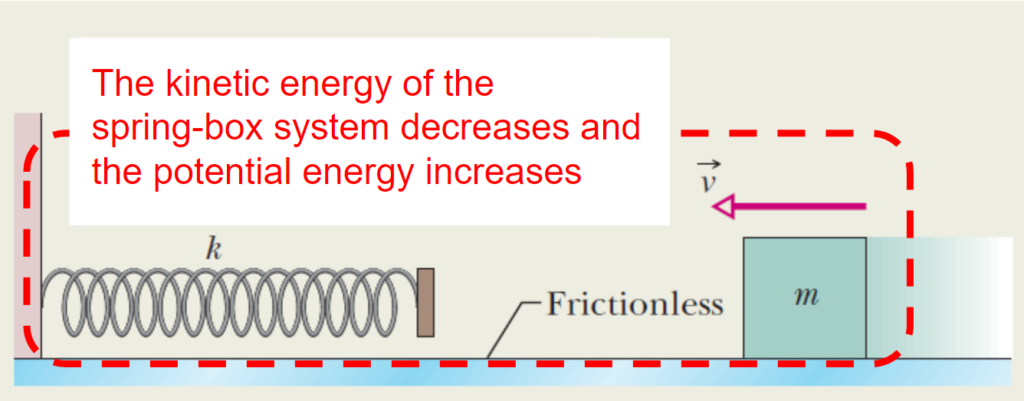
ΔEtotal = ΔEK + ΔEelastic potential = 0
The kinetic energy decreases while the elastic potential energy increases by the same amount.
ΔEK = – ΔUelastic potential
When work is done on a system, it changes the mechanical energy of the system.
Work is equal to the change in energy of the system.
Work and forces
How do forces do work?
Forces act to transfer energy, and to change the form of energy.
We call the amount of energy transferred by a force the work done by that force.
The amount of energy transferred to an object when a force acts on it is given by:
where F is the force applied to the object in the direction of the object’s displacement, and s is the displacement of the object.
How do multiple forces do work?
When two or more forces act on an object, the net work done on the object is the sum of the works done by the individual forces. The net work is also equal to the work that would be done on the object by the net force of those forces.
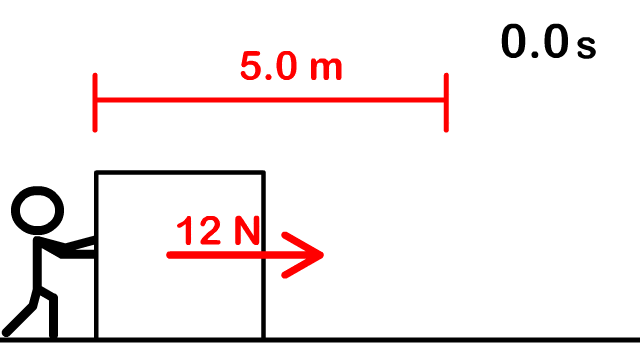
In the animation above, the stick person does work on the box, but the total kinetic energy of the box doesn’t change. This is because there is another force which also doing work on the box: friction (not shown). Because the box is moving at constant speed, the friction force must be equal and opposite to the force applied by the stick person; and Fnet = 0.
Can a force do no work? (extension)
The fact that a force acts on an object doesn’t mean that the force will do work on the object. Here are two common cases where a force does no work.
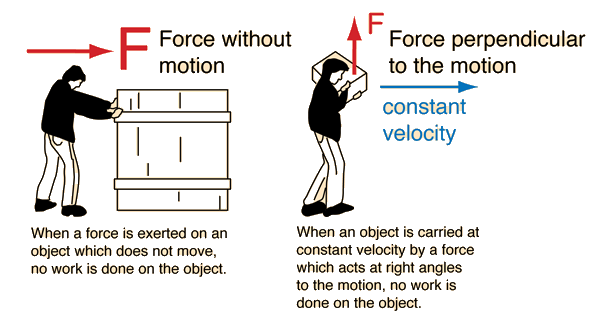
Why is work a useful concept?
When the work done on an object is positive, so that the force is in the direction of motion, the kinetic energy of the object increases. When the force is in the opposite direction to the motion, the object slows down and its kinetic energy decreases.
The total work done on an object, Wnet is equal to the work done by the net force acting on the object, Fnet. This work causes a change in kinetic energy, ΔEk
Thus, we can use the concept of work to calculate the change in speed of an object.
Remember, the displacement is in the direction of motion of the object. The distance moved doesn’t matter, only the displacement.
What is the work done by friction?
Friction causes an object to lose mechanical energy. Usually, the energy is transformed into heat and sound.
Because the kinetic friction force always opposes the motion of the sliding object, the force is always opposite to the displacement vector. For this reason, we need to use the distance travelled by the object instead of the overall displacement.
Potential energy and Gravitational Potential Energy
What is potential energy?
Potential energy is stored energy, ready to do work. Whenever a force acts on an object, there is a potential energy associated with that force.
Objects can have potential energy as a result of their position in a force field. For example:
- Objects with mass in a gravitational field have gravitational potential energy
- Objects with charge in an electric field have electric potential energy.
A compressed spring also has potential energy. If released, the spring is able to do work by applying a force through a distance. This is called elastic potential energy.
Elastic potential energy is really another form of electromagnetic potential energy, because the force that a spring exerts is due to its atoms being pushed closer together or pulled further apart than their normal distance. Atoms interact via their electrons and the electromagnetic force.
What is Gravitational Potential Energy?
Gravitational potential energy is the potential energy of a mass resulting from its height (it’s position in a gravitational field). Raising a mass in a gravitational field increases the gravitational potential energy
But what is the height of an object like a book sitting on a desk?
We are usually concerned about changes in potential energy, ΔEp (the difference in potential energy between two points):
How to calculate the work done to lift an object?
The work done on a mass while lifting it is equal to the change in gravitational potential energy the a mass, ΔEP:
Why is ΔEP = mgΔh? (extension)
ΔEP = Work = F||s
The work done on the box depends on the displacement of the box, which is equal to its change in height, Δh = hf– hi
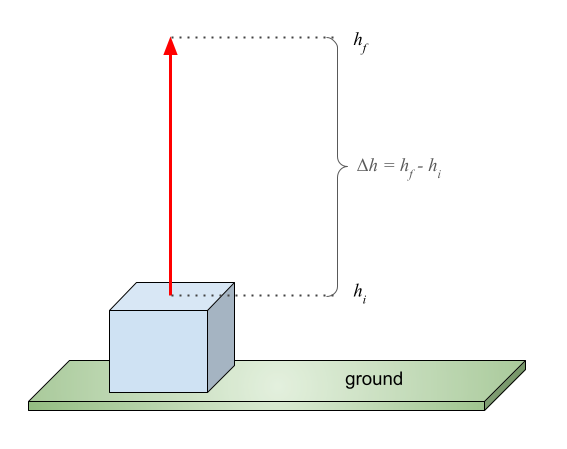
The force that must be applied to the box of mass m is equal to the weight of the box, Fg = mg.
This allows us to derive an expression for the change in gravitational potential energy, ΔEP :
ΔEP = Work = F||s = mgΔh so:
ΔEP = mgΔh
A few things to note
Why not use g = -9.81 m s-2? The negative sign tells us the direction of the acceleration. Very simply: we don’t care about the direction because we are using the value simply to calculate the Work done on the object, which is a scalar (directionless) quantity.
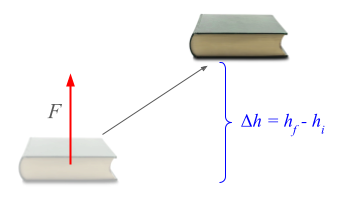
We only care about the change in height of the object, not the distance that it travels. (That’s the displacement in the same direction as the force required to lift the object, which is upward).
Gravity, work, and Conservation of mechanical energy
How to use the law of conservation of energy on falling objects?
We can state the law of conservation of energy as:
ΔEtotal = ΔEk + ΔEP = 0.
This means that the total mechanical energy in an isolated system remains unchanged.
This means that the total mechanical energy in an isolated system remains unchanged.
For an object falling freely in Earth’s gravitational field, the potential energy lost as an object falls must be converted to kinetic energy.
EP → Ek
ΔEk = -ΔEP
The negative signs can confuse some students – just remember that if Ek increases, then EP decreases
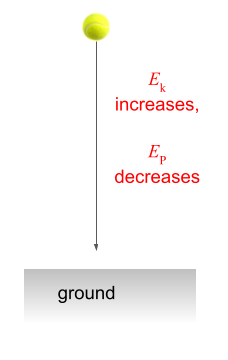
How to calculate speed from a change in energy?
The change in kinetic energy is equal to the final kinetic energy minus the initial kinetic energy.
ΔEk = Ek.final – Ek.initial = ½ mv2 – ½ mu2
In most problems, the object will be at rest initially, so the initial kinetic energy will be equal to zero: Ekinitial = 0. Thus:
ΔEk = Ek.final = ½ mv2
Roller coasters and conservation of energy
What energy is conserved in a roller coaster?
In the absence of friction, total mechanical energy is conserved.
How to solve problems – method 1
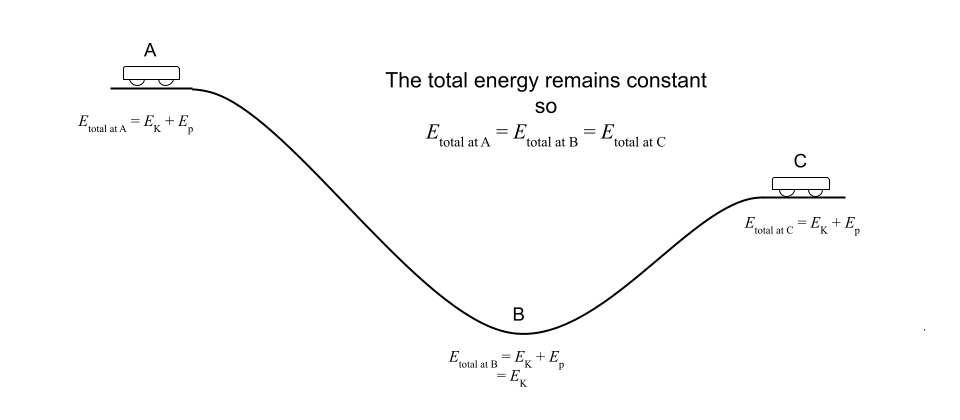
How to solve problems – method 2
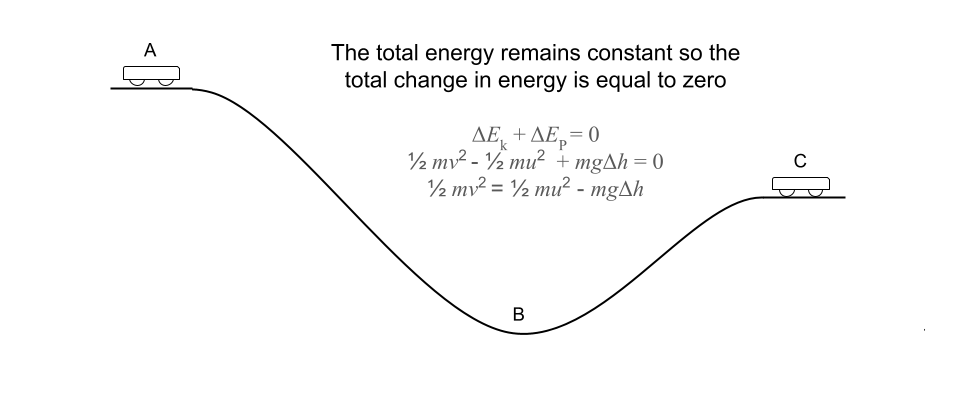
Elastic and inelastic collisions
The terms elastic and inelastic are often confusing for students. They have a completely different meaning to that used when we describe an elastic band.
The collisions between pool balls are (approximately) elastic collisions. A Newton’s cradle toy demonstrates (approximately) elastic collisions between steel balls.
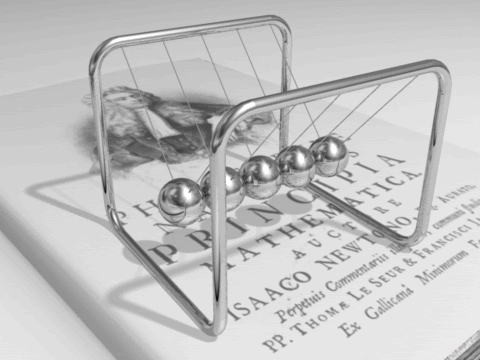
When is kinetic energy conserved?
Momentum is always conserved in any interaction, as is energy. But unlike momentum, energy can change forms.
When there is a collision between objects, the total momentum of the objects before the collision must be equal to the total momentum afterwards. However, the total kinetic energy afterwards may not be equal to the total kinetic energy before.
When the total kinetic energy is the same before and after the collision, we call it an elastic collision.
How does kinetic energy change in collisions?
Momentum is conserved in each of the following three collisions.
In all cases the total kinetic energy before the collision is:
EK.initial = ½ × 8.0 × 102 = 400 J
What is an elastic collision?
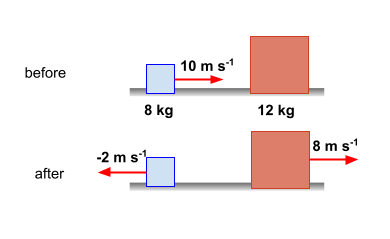
EK.initial = ½ × 8.0 × 102 = 400 J
The total kinetic energy after the collision is:
EK.final = ½ × 8.0 × 22 + ½ × 12 × 82 = 400 J
When kinetic energy is conserved, the collision is said to be elastic.
What is an inelastic collision?
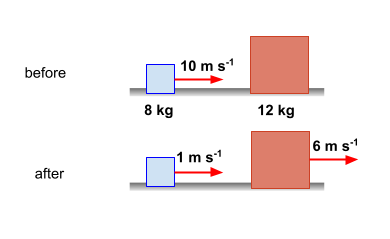
EK.initial = ½ × 8.0 × 102 = 400 J
The total kinetic energy after the collision is:
EK.final = ½ × 8.0 × 12 + ½ × 12 × 62 = 220 J
When kinetic energy is not conserved, the collision is inelastic. In an inelastic collision, kinetic energy is lost.
The lost kinetic energy is transformed into other forms of energy, such as thermal energy, deformation energy (if the bodies are permanently deformed as a result of the collision) and sound energy.
What prevents collisions from being perfectly elastic?
Friction usually results in the transformation of kinetic energy into heat and sound.
What is a totally inelastic collision?
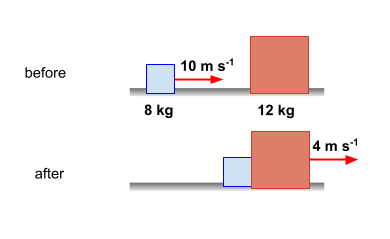
EK.initial = ½ × 8.0 × 102 = 400 J
The total kinetic energy after the collision is:
EK.final = ½ × 20 × 42 = 160 J
When the bodies stick together after a collision, the collision is said to be totally inelastic (or plastic), and in this case the maximum possible kinetic energy is lost.
Power
What is power?
The rate at which work is done is called power, P. As work is the energy transferred by a force, power is the rate at which energy is transferred, or transformed from one form into another.
The units of power are Joules per second (J/s), but this unit is used so often that we have a special name: the Watt (W).
Obviously, the amount of energy transformed or transferred in a process is the power multiplied by the time interval:
